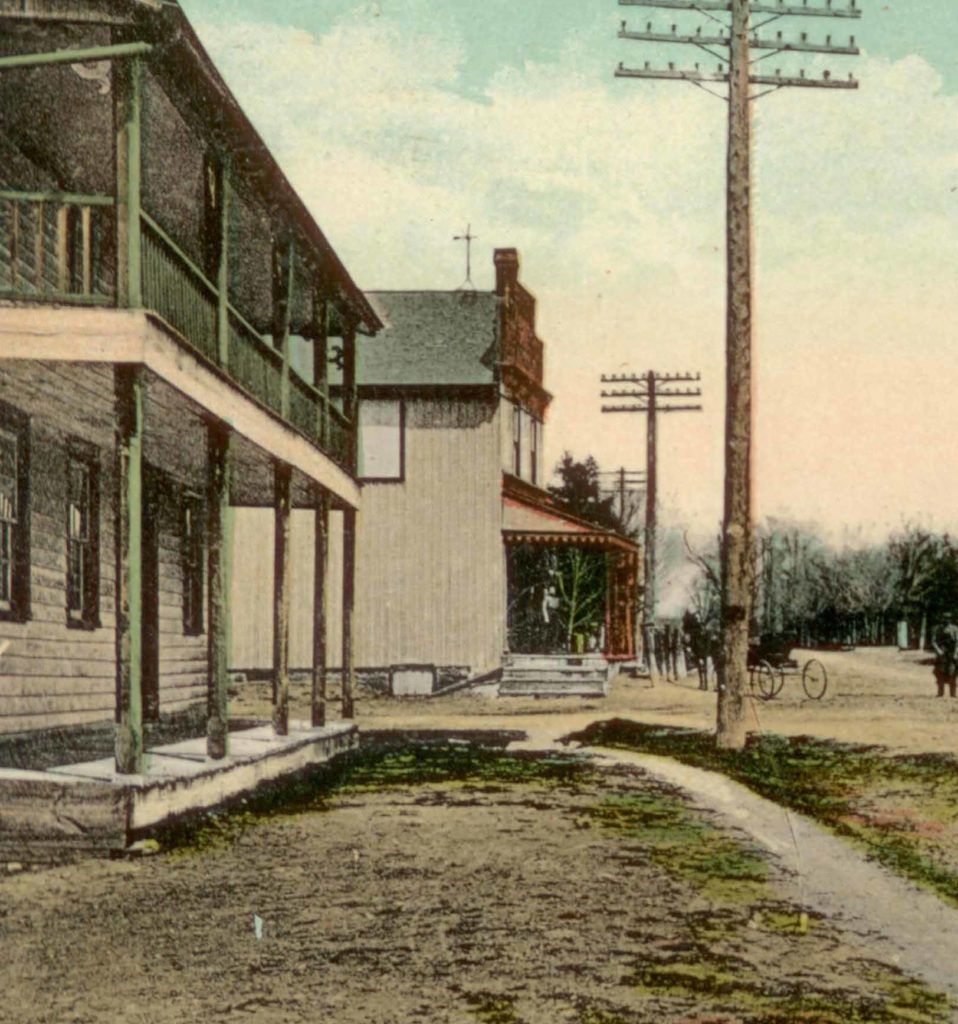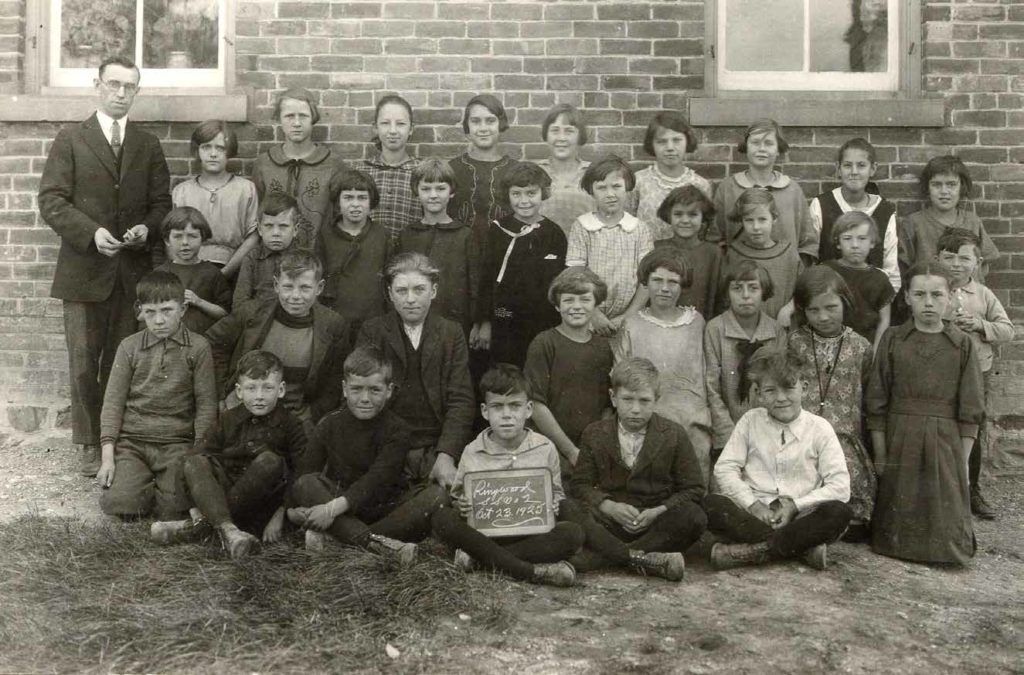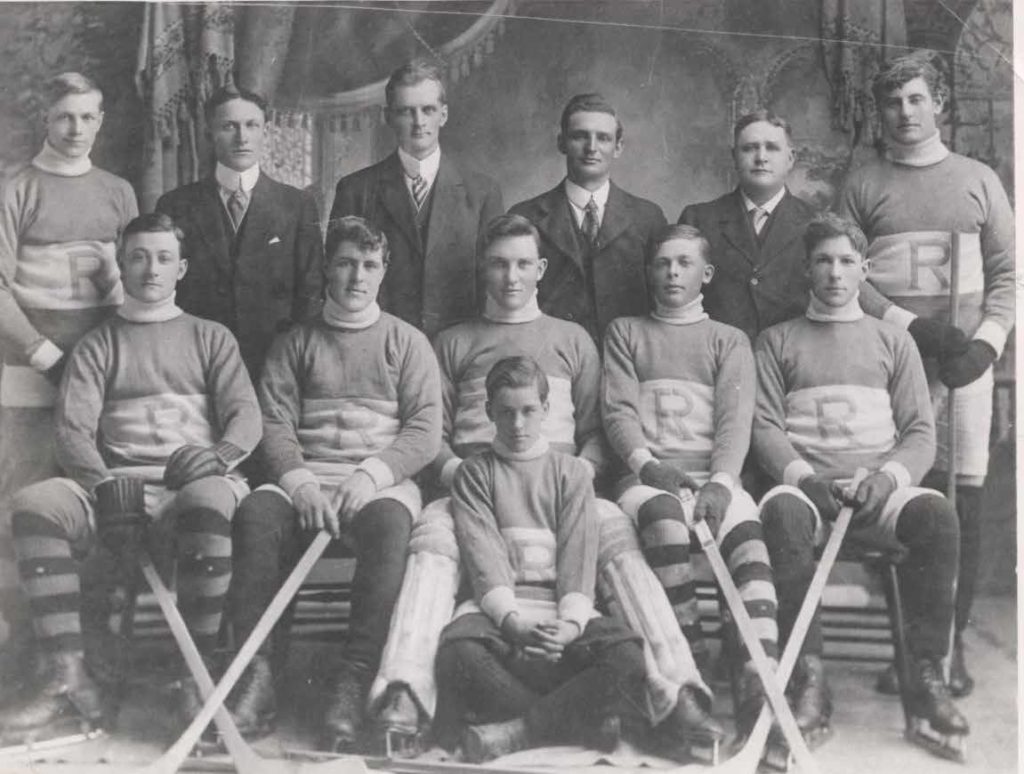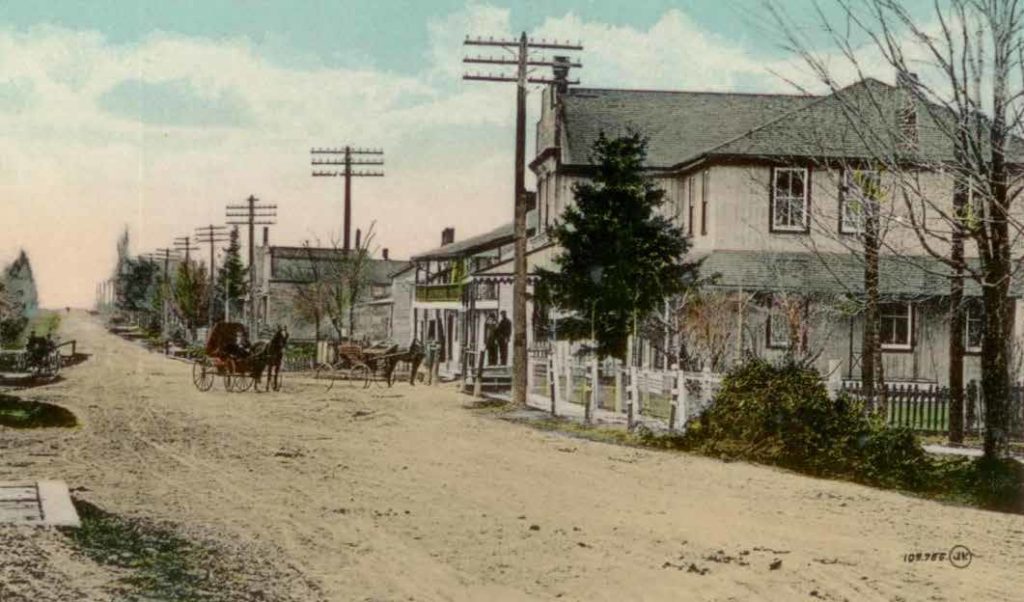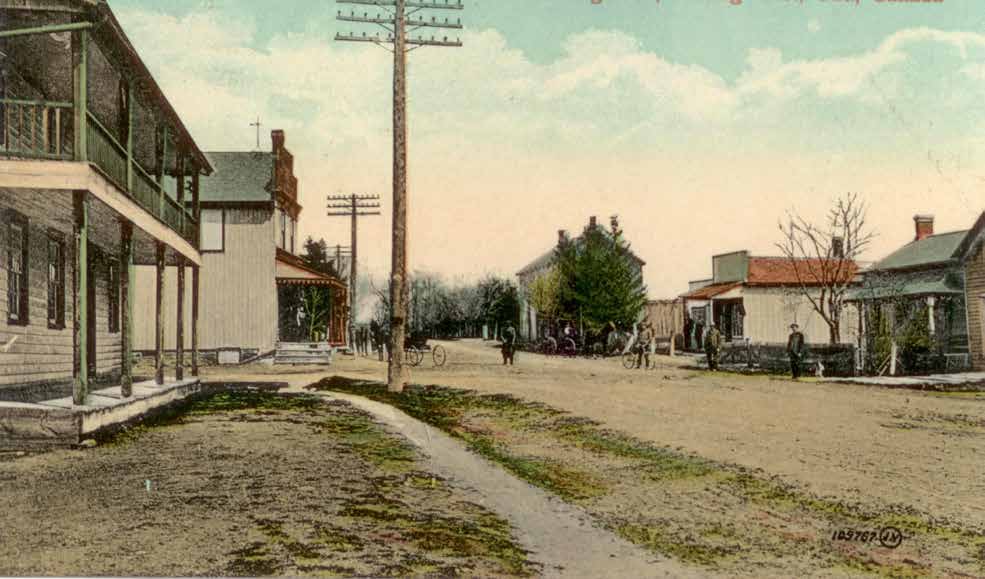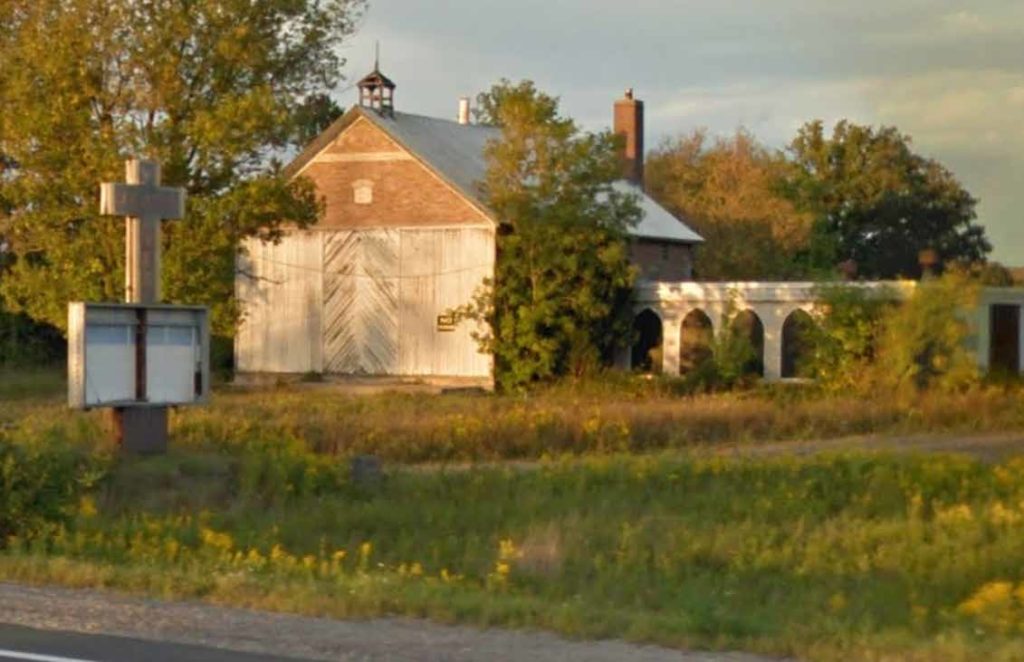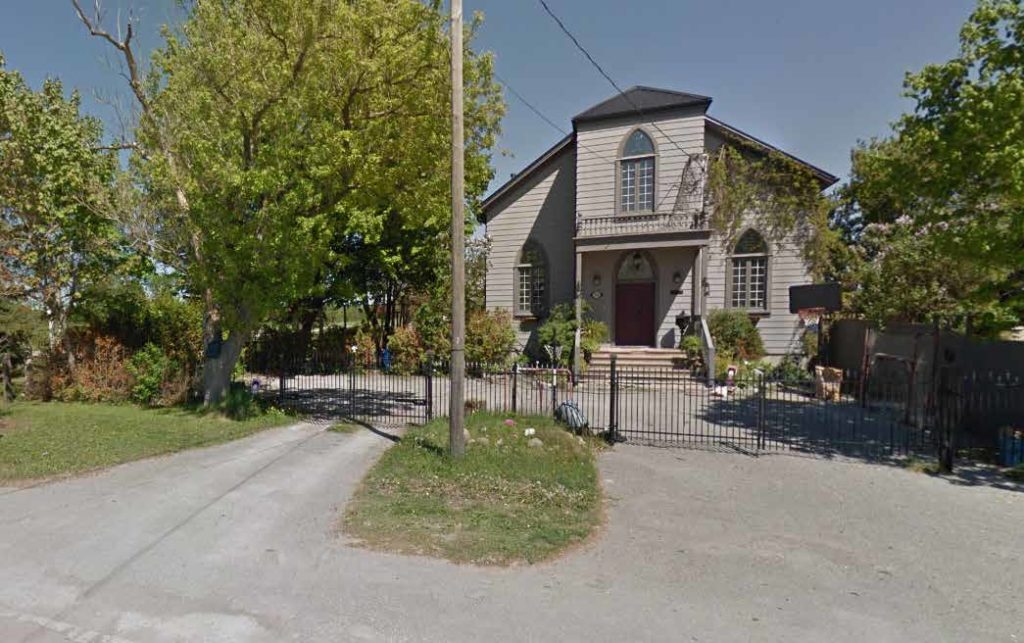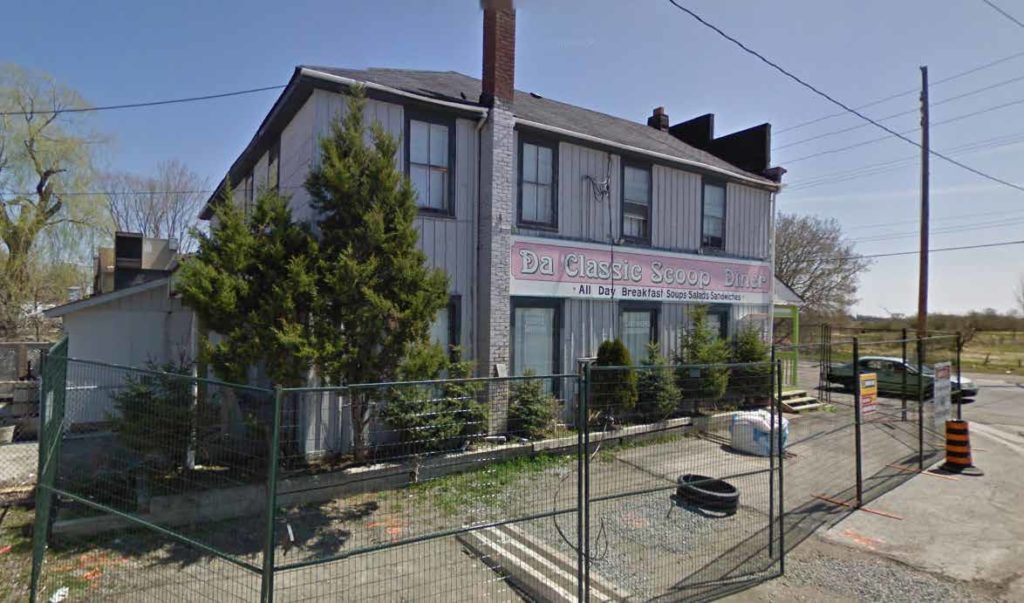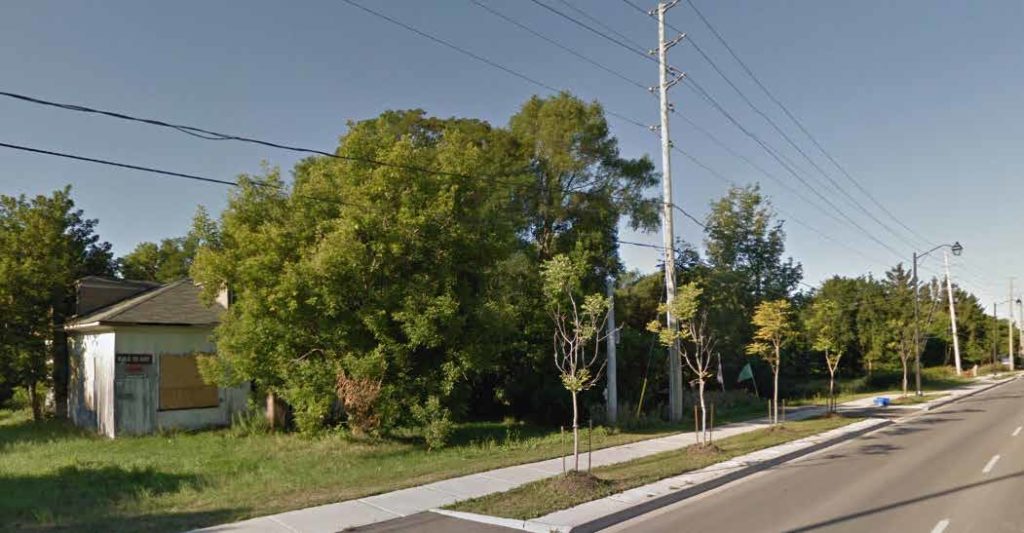Ringwood 1800-1950, this is the story of a community that gained an essential position in history, but is now a forgotten place.
The George Fockler family of Pennsylvania were the first to settle the area of Ringwood in the late 1790s. They built a home at the northwest corner of the intersection of Townline and 8th Concession (present Stouffville Rd. and Highway 48). In those days, Townline formed the boundary between Markham and Whitchurch Townships. Peter Wideman settled the southeast corner of the intersection in 1803. George and Elizabeth Brownsberger moved here from Pennsylvania in 1826. These pioneers began to clear the forest for farms. The first crops were sown and harvested by hand. They grew enough crops and raised enough animals as to be self-sufficient.
Another early resident was George Sylvester from Ringwood, England. He opened a general store on the northeast corner; when he became the first postmaster for the hamlet in 1856 – he named it Ringwood.
In the early days, we had a plank road (a board walk of sorts) that connected Stouffville to Richmond Hill, by way of Ringwood. The stagecoach used to pass our home. The driver, Mr. Marshall had one of the largest mustaches I have ever seen. We didn’t have much in those days – Silvester’s store, Philip Wideman’s marble shop (grandson of Peter), MacPherson’s wagon shop, and a blacksmith shop. There were only a half dozen houses scattered about.
Our early post office was not in Ringwood, but 2½ miles down 8th concession at Milne’s Sideroad. Newbury Button bought a farm on the west side of town. The Ringwood School was built in 1838, and the Ringwood Christian Church built in 1868. Ringwood School Class of 1925 [courtesy of W-S Museum] By 1870, the community grew to 100 residents with 21 businesses.
After a few years, a boom stuck. Business flourished, we had everything – 2 hotels, 2 general stores, 2 shoe shops, a harness shop, 2 sawmills, 2 cheese makers, a livestock dealer, 2 blacksmiths, a cider maker, a life insurance office, an auctioneer, a butcher, a shingle mill, 2 carriage makers, a builder, a weaver, and a flourmill.
A bunch of houses were added to Ringwood too. Every family along the road had 8 to 10 children each. Ringwood’s population grew to around 300 by 1886. The original one-room frame schoolhouse was replaced in 1887 with a red brick school, built northeast of the corners (it is still there today with the signage of a defunct church – “Jesus”).
Ringwood had one of the finest brass bands, with many Lehman boys belonging to it. The brass band supplied the music for the annual Orange Walk. The hotels doubled as a location for auctions: Button’s Ontario House Hotel ended the 1892 year with a sale of 20 first class pregnant ‘milch’ cows, 10 yearling steers and many sheep and pigs.
Stivers’s Hotel began the new year of 1893 with the sale of household furniture and furnishings. For Thanksgiving of 1889, Messers and Brownsberger announced a shooting match to be held at Stiver’s Hotel; about 60 head of turkeys and geese will be the subject of No. 6 shot at a distance of 90 yards. Two of our own – Newbury Button and Jacob Grove were both appointed Justices of Peace for the County of York.
Alas, by 1900 the population of our community has fallen to 220, with 14 businesses – a 27% and 42% reduction respectively in just over 10 years. Attending the hockey matches is a great pastime. In 1916 the cost of entry was 15 cents, and presented an opportunity to see the Ringwood boys go head to head with Lemonville, Stouffville, Vandorf, Mt. Albert or Claremont.
The year of 1918 was shocking for the world, because of the war and for local matters. In March, Israel Schell was struck and killed by a street car in St. Catharines; he had been walking on the tracks – on account of the muddy conditions – and did not hear the car approach, which was reported to be travelling at excessive speed.
Also in 1918, the Spanish Flu, which was killing more people than World War I (an estimated 500 million people died worldwide – about one-third of the planet’s then population), struck the Stouffville area.
Public meetings were forbidden, the library and pool-rooms ordered closed and warnings were made about the risk of Christmas shopping.
The epidemic was serious around Whitevale, Locust Hill, Claremont and here, with new cases being reported daily, yet only one death resulted prior to Christmas. Most of the annual Christmas activities were cancelled.
1922 has shaped up to be a banner year for Ringwood. First, in June, the Christian Church of Ontario held its annual conference in the Ringwood Church. A visiting reverend from Ohio delivered an aweinspiring sermon. A record audience was in attendance, which taxed the building to its capacity.
Then in September, Ontario Premier King was met in Ringwood by the 48th Highlanders Band and mounted veterans acting as escorts for a 2 mile parade walk into Stouffville. Pupils from all the schools in the neighbourhood fell in with the march. The year ended finely with the annual Christmas tree and concert at the crowded and cheerful Ringwood School.
In 1923 McKenzie, the “canny Scot” and popular garage owner, installed a generator to make his own electricity and light in advance of hydro being available. Ringwood lost to Stouffville in a narrow defeat of 7-8; our hockey hopes were high when we were up by 3 in the first five minutes, but they couldn’t hold the pace.
The school has been closed for a few days, owing to the measles outbreak, and the annual school concert was duly cancelled. The first sign of Spring came with the opportunity to buy Choice Gladiolus Bulbs from W.J. Jacobs for 25 cents a dozen.
Good news about hydro, its now reported that the rates may be as low as $1.90 per month; we were worried about the earlier report of $3, which is very high. Perhaps soon we shall see some of our homes and business places illuminated with the great white current from Niagara. Hugh Boyd almost lost his brother Alex of Markham, due to the fact that Alex was driving a truck load of cattle up from Toronto which collided with the Stouffville four o’clock train at Unionville Station; he and the cattle escaped with minor injuries, but the truck was a complete wreck.
The ice cream social at the Ringwood School proved to be a good program for all those involved, despite the August heat.
Chickens! F.A. Bruels’ new model brooder stove is capturing all the talk. The larger of the two models has 1000 chick capacity in a mere 52-inch canopy, burning coal or coke. One of John Fisher’s Plymouth Rocks produced an egg that measures 7 ½ x 9 inches and weighs 5 ½ ounces – it may win largest egg in the province. The chickens were surely shaken by that 9.2 earthquake we felt in March – the dishes were shaking and the pictures swaying.
About 60 from around our burg spent the evening at the home of Mr. Kenneth Campbell. We had a very enjoyable evening of games and music; afterwards, oysters were served.
July brought another sad reminder about the fragility of life when one of our esteemed citizens, Abram Lehman died, at age 76. Mr. Lehman’s parents were one of the early pioneers in this section. He used to run the carriage shop and general store here, before opening an ice cream shop in Stouffville.
The 1925 school year started off with 36 pupils, five being beginners. Our school beat Stouffville in the singing contest at the Stouffville fair. It is reported that a young man from here made his first trip to the Exhibition – he stood so long gazing up at the skyscrapers at King & Yonge that the roof of his mouth got badly sunburned.
Mark this date – February 4, 1926: we now have bus service available 7 days a week from Ringwood to Toronto. After Ringwood, it serves Stouffville too. 10 trips on the Maple Leaf Bus Lines for $7.00. About 25 passengers were onboard today. Many improvements came to our burg this spring: the hotel property was electrically lighted under the management of Mr. Sinclair, Albert Pemberton took over the property and blacksmith business vacated by Ernest Watson, and the Ringwood Garage was renovated again – they now have a washroom for ladies!
L.A. Brownsberger, the fruit expert, pruned 15 acres of orchards. He says there are good prospects for all kinds of fruit. Sad news came in July – Wellington Stouffer died in the lane from heart trouble while doing his evening chores at his Ringwood barns; few men were more highly regarded in the community.
J.L. Grove and sons have 1300 ducks hatched. Under the Corn Borer Act, all stubble must be destroyed or plowed under by May 20. Another large hole washed in Mr. Jones’s mill race during last week’s flood; we’re looking at buying a boat for getting around Ringwood. J.J Rae’s are advertising a lot of Ringwood Cheese for sale. It has been announced that a gold fish farm is coming to a plot one mile north on the 8th Concession.
McKenzie’s is selling closed cars, 1928 Chevrolets – winter would be easier with one of those to keep you warm. A great number of citizens attended the Royal Fair. Our trappers are busy these days setting traps for the season’s catch of mink. Five of our hunters returned home this week from the Nipissing District, each with a deer. It is reported that Bruce Stouffer, who went west for the harvest, secured work with General Motors in Regina; he may not be back for a while. The Ringwood Garage is up to 7 hands – it’s a busy corner.
April 11, 1929. Considerable damage was done to Ringwood during Friday night’s storm. We were nearly submerged in the flood waters that came from the north. Fences, dams and bridges were wrecked.
Of the hundreds of culverts and roads and lanes in Markham and Whitchurch Townships, 90% are damaged or destroyed. A foot of water flooded the floors of Ringwood Garage, while the furnace pit held 3 feet of water.
Despite the rains of last spring, the ground is dry in October. The Toronto Gold Fish Company continues the work of sinking wells. Both locals and authorities are watching with more than ordinary interest, as the new wells are being sunken near the Stouffville town wells – the ratepayers may be injured! The most recent well completed gave a flow better than the previous four, but it was a gusher of short duration. In the meantime, the wells on the Mortson and Sinclair farms have dried substantially. There is no law on statute books to prohibit drilling in wholesale quantities.
With great merriment, about 50 people gathered for Grandma Hoover’s 90th birthday. Although she has been confined to a chair for the past years, her mind is very alert and she participated in the enjoyment to the full extent. We understand that 8th concession will be surfaced from Ringwood to Baker Hill with tarvia this summer (a tar and gravel substance). With this section built, Ringwood will boast hard surface roads year around!
The Gold Fish Supply Company has hired Charles Dadson to guard over the fish ponds, against crows, hawks, gutter snipes, and prowling animals that prey on the fish. On the note of birds, Starlings are coming in such numbers as to turn day as overcast, yet you could kill 17,000 and have a million come to the funeral. They seem to be driving out the good birds that destroy insects and sing songs, such as the morning doves, swallows and woodpeckers. These starlings carry deathly chicken diseases, they eat our fruits and vegetables, and they bring death to the trees where they roost. Mark this date – January 1939. When winter is at its darkest, the Ringwood School Trustees voted against the installation of electric lights.
One farmer said that he would invest if it was growing and worth fixing up. He said that he pays $1,200 a year for only 13 pupils at the Ringwood School – a weak investment. The trustees also voted down a motion to hire a dedicated music teacher.
The winter of ’42 has proved rough. The February snowstorm brought 10-foot snowdrifts and closed all roads to incoming food supplies. General store owner John Sinclair said that he was preparing to ration his customers. “Our supply of milk was almost exhausted by the time the plows got here,” said Mr. Sinclair.
The former Button Hotel, having operated as the Sinclair Place this past 20 years, has been sold to John Hicks of Niagara. Our population has dropped to about 100. Grove’s Store is about the only business still operating.
Special Focus – In Retrospect
8th Concession (Highway 48) used to be staggered at Townline (Stouffville Rd.), meaning that vehicles would have to jog east or west in order to continue north or south. The roadway was widened and straightened in 1957 to the current alignment. As a result, one of the hotels, a harness shop, two garages and several homes were destroyed – the four corners of traditional Ringwood were no longer.
The Ringwood School, despite being expanded in 1956 (the addition on the south side), was closed in 1971, along with the schools at Bloomington, Pine Orchard, Lemonville, Pottageville, Shrubmount, Melville and Hagermon. The Ringwood Post Office, serving a reduced population of 40, was closed in 1970; other sources state 1975 for the closure. Further hastening Ringwood’s decline, a farm on the north side of Ringwood became the subject of the largest seizure of hashish ever in Canada in 1971. The Ringwood Christian Church seems to have closed around 1997.
The only remaining retail business in Ringwood, the Ringwood Cafe – reportedly a biker hang out – is now boarded up. Florence (Brownsberger) Yakely, a native of Ringwood, wrote “No longer are weary farmers and teams called from the harvest field by their own dinner bell; no longer are heard the ringing blows of the local blacksmith; and no longer is a honey-pail full of warm milk carried home from Grandma Fockler’s spotted cow. No longer, in 1975 does the green highway sign even mark – Ringwood.”
The biggest question remains – why did Ringwood fail as a community? It would be easy to say: after several property-gobbling road widenings, and after the school, church and post office closed – how could it survive? But this would be short of the reality. Ringwood reached a population of 100 in 1870, peaked at 300 in the mid-1880s, and declined back to 100 persons by 1950. It was a community of 30 years of rapid growth, and 70 years of slow decline.
This is a puzzling riddle – if every family had 8-10 children, population growth should be the result, right? However, it appears the population did grow, but rather in other places. You can see this trend in display advertising in the local newspapers – Ringwood was a powerhouse of business Ads in the Eighteenth Century, but after 1900, mostly Stouffville and Markham advertisements dominated the papers. It was more a matter of migration, rural to urban – from Ringwood to somewhere else.
According to the Canadian Encyclopedia, “in 2011, 86 percent of Ontario’s population was urban. By comparison, 160 years earlier, in 1851, the figures were reversed: 86 percent of Ontario’s population was rural. These numbers reflect the fact that, in addition to being the most populous province in the country, Ontario is also the most urban.”
However its current state, Ringwood continues to have an essential position in our area history. A lot of the residents of Whitchurch-Stouffville are descendants of these early pioneers. Ringwood may have died, yet it fueled the growth of Stouffville and other towns in the area. Its blood still flows.
Sources
The historical information for this article was gathered from 65 articles in a variety of newspapers. And from two white papers found in the Ringwood File at the Whitchurch- Stouffville Museum & Community Centre – one by Fred Robbins entitled “Ringwood Community Heritage Conservation District, 2008”; the other is named “Ringwood” by an unknown author and unknown date, although evidence would suggest that it is written by a daughter of the Brownsberger family named Florence Yakely in 1975.
